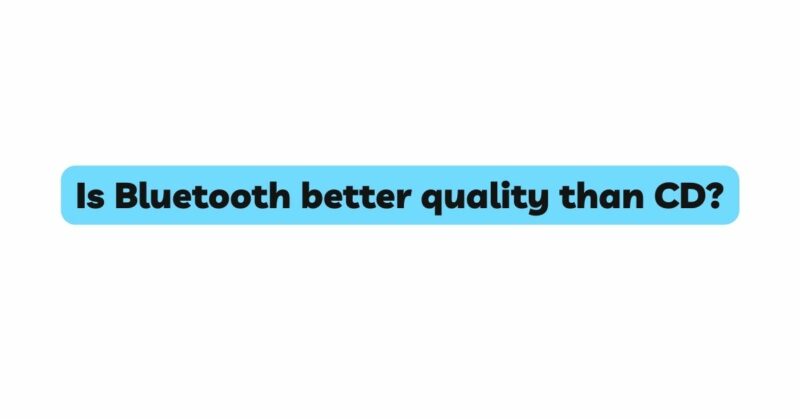The world of audio technology has undergone seismic shifts in recent decades, morphing from analog to digital, from CDs to wireless streaming. Amidst these transformations, two giants have emerged – Bluetooth and Compact Discs (CDs), each vying for supremacy in the realm of audio quality. This article delves into the intricacies of sound reproduction, dissecting the attributes and limitations of both Bluetooth and CD formats, ultimately aiming to unravel the question: Can Bluetooth genuinely claim superiority over the revered audio fidelity of CDs?
The Sonic Evolution: CD vs. Bluetooth
The advent of the Compact Disc in the 1980s marked a watershed moment in audio history. CDs heralded the era of digital audio, offering a quantum leap in sound quality compared to analog formats. The magic behind CDs lies in the Pulse Code Modulation (PCM) technique, which transforms analog audio signals into a precise series of numerical samples. This process, coupled with the storage capacity of CDs, ensures that the listener experiences an unadulterated representation of the original recording.
Bluetooth audio, on the other hand, is a contemporary champion in the wireless era. Initially conceived as a means to connect peripherals, Bluetooth has metamorphosed into a potent audio transmission technology. It promises freedom from cords and a seamless, wireless music-listening experience. Bluetooth codecs like Advanced Audio Codec (AAC), aptX, and LDAC have emerged to facilitate higher quality wireless audio transmission, with the intention of bridging the gap between wired and wireless audio.
Bitrate and Compression: The Silent Architects of Audio Quality
At the heart of the Bluetooth vs. CD debate lies the intricate interplay between bitrate and compression. Bitrate quantifies the amount of data processed per unit of time and is measured in kilobits per second (kbps). In the realm of CDs, the bitrate is a formidable 1,411 kbps, ensuring that the full sonic spectrum is faithfully captured. Consequently, the audio experience is akin to witnessing a live performance, with each sonic nuance meticulously preserved.
Bluetooth audio, due to the constraints of wireless transmission, employs data compression to ferry audio files across the airwaves. The extent of compression varies depending on the codec used. While initial codecs like the Subband Coding (SBC) sacrificed audio quality for the sake of wireless transmission efficiency, modern codecs like aptX HD and LDAC aspire to minimize data loss. However, some level of compromise remains inevitable, especially when compared to the uncompressed nature of CDs.
The Audiophile’s Quest for Sonic Purity
For the discerning audiophile, sound quality transcends mere auditory pleasure; it’s a journey of sensory transcendence. Audiophiles crave a listening experience that mirrors the artist’s intent, unfettered by any distortion or data loss. In this pursuit, CDs have held an unrivaled position. The analog-to-digital conversion process and the absence of data compression mean that CDs faithfully replicate the essence of the original recording, allowing audiophiles to revel in the music’s raw, unadulterated form.
Bluetooth audio, while consistently evolving, must contend with the constraints of wireless transmission. Audiophiles might argue that even with high-quality codecs, there’s a perceptible chasm between Bluetooth and CD quality. While Bluetooth has made strides in bridging this gap, discerning listeners with finely tuned ears might detect minute differences, attributing them to the inherent limitations of compression.
Context Matters: Real-World Listening Scenarios
The dichotomy between Bluetooth and CD quality becomes even more intriguing when considering the listening environment. In controlled listening conditions, with high-quality headphones or speakers, the distinctions between Bluetooth and CD quality might be more palpable. However, in everyday scenarios like casual listening through Bluetooth speakers, earphones, or even car audio systems, external factors such as ambient noise, room acoustics, and the quality of audio gear can significantly influence perceived differences.
The Driving Factor: Convenience vs. Fidelity
In the era of immediacy and mobility, Bluetooth’s allure is irrefutable. Its seamless integration with smartphones, tablets, laptops, and even vehicles has made wireless audio an integral part of modern life. Bluetooth’s supremacy lies in its convenience – the ability to enjoy music without the tangle of wires and the freedom to switch between devices effortlessly.
CDs, on the other hand, demand a return to physical media and dedicated players. This ritualistic experience resonates with those who value the tactile interaction with music. However, CDs may be perceived as cumbersome in comparison to the on-the-go fluidity offered by Bluetooth audio.
Conclusion: A Harmonious Coexistence
In the grand symphony of sound, the question of whether Bluetooth audio is superior to CD quality defies a definitive answer. Both technologies have their distinct merits and limitations, and the verdict often rests on individual priorities. For audiophiles, the authenticity of CD-quality audio holds an undeniable charm, while the convenience and wireless freedom offered by Bluetooth audio resonate with the modern lifestyle.
Advancements in audio technology continue to blur the lines between Bluetooth and CD quality. Bluetooth’s evolution into higher-quality codecs and the consistent refinement of wireless audio transmission bridge the gap, bringing listeners closer to the audio nirvana offered by CDs.
In the end, the choice between Bluetooth and CD quality is less about a winner-takes-all scenario and more about a harmonious coexistence. Each format caters to diverse preferences, offering a melodic journey that adapts to the rhythm of modern life. Whether you’re an audiophile seeking pure sonic purity or a pragmatist embracing the wireless future, both Bluetooth and CDs enrich our lives with the gift of music.


